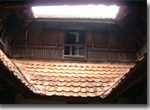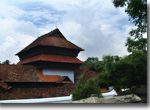Padmanabhapuram Palace

The old princely state of Travancore which was developed from the ancient kingdom of Venad occupied the South-West portion of the Indian peninsula. The term Travancore is the English version of ‘Thiruvithamcode’ or ‘Sreevazhumcode’; means the abode of prosperity.It developed from the little known kingdom of Venad, which was otherwise known as ‘Velnad’ or ‘Vanavarnadu’.It was known by many other names also but none were as prominent as th ename ‘Vanchidesam’. This refers to the fact that it was the kingdom of the descendants of the ancient Chera Kings whose capital was celebrated ‘Thiruvanchikulam’ known as Kodungalloor.
The center of Travancore was the petty principality of Venad comprising the territories lying between Thiruvananthapuram and Kollam with its capital at Kollam. P. Sankunni Menon in his book “ A History of Travancore from the Earliest Times” give a traditional history of Venad. According to that tradition Venad came into existence on 12th Makaram (3412 of Kali year) corresponding to the 29th January 311 AD. When Veera Kerala Varma was crowned as the king with it’s the titles “Kireedapathi” and “Kulasekhara Perumal”. His capital was Veera Kerala Puram near Thiruvithamcode. In the following decades the royal family happened to reside at several places thus giving birth to different branches or Thavazhis namely Thrippapur, Deshingnadu ( Jyasimha Nadu), Elayyidathuswaroopam (Kottarakara) and Perakamswaroopam ( Nedumangadu). The sovereignty of Venad was not hereditary in the early years. Another view is that a branch of “Ay” family with its headquarters at Thrippapur merged with “Chiravayaswaroopam” at Athenthuruthy. His argument leads to the conclusion that the Venad ruler used the title of Chiravaya Moopan while the junior prince took the title of Thrippapur Moopan with the specific responsibility to administer Sree Padmanabha Swami temple in particular and other temples in the State in general. It is difficult to define the relation between these Thavazhis, but circumstances indicate that the senior competent member of this collateral branches ruled as Kulasekhara Perunmal.
The first Venad king known by inscriptional evidences was ‘Ayyan Adikal Thiruvadikal’ who ruled in 849 AD. He and the heir aapparent ‘Ramar Thiruvadi’ were the contemporaries of ‘Sthanu Ravi’ whose reign commenced in 844 AD. The next Venad king about whom we have inscriptional evidence is Sri Vallabhan Kotha, the signatory of Mamballi plate. The next king ‘Govardhana Marthandan’ came to throne in 976 AD and was a contemporary of Chera emperor “Bhaskara Ravi Varman”. His inscriptions in Thrikkodithanam temple and the Jewish copper plate show that Venad at that time was a vassal of Chera empire.
In the early days of royal seat of Venad was at Kollam. The copper plate grant of Ayyan Adikal Thiruvadikal, the first of the early Venad kings of whom we have inscriptional evidences show that he issued the grant from his royal seat at Kollam. “Sukasandesam”, a Sanskrit poem belonging to the beginning of 13th century refers Kollam as the ‘Kulapuri’ of the Kupaka kings of Venad. ‘Unnuneeli Sandesam’ which belongs to the 14th century also speaks of Kollam as the capital of Kupaka kings. Even now the history of Kerala is silent about the reason and period of shifting the capital of Venad from Kollam to Kalkulam due to the absence of authentic records. Towards the beginning of the15th century, Thrippapur Moopan, the heir apparent seems to have built a place at Thiruvithamcode and stayed there until Darpakulangara Palace was built at Kalkulam.
Inscriptional evidences suggest that the Kalkulam fort with an area of 186 acres was constructed in 1601 A D. It may also be presumed that the palace had come into existence earlier than the fort. The first reference about Kalkulam palace shows that Sri Veera Ravi Varma Kulasekhara Perumal (1590-1609 AD.) went to Madurai from Kalkulam. At that time Travancoe was only a small kingdom comprising Nanchinadu in the South and Idava in the North.
When Maharaja Marthanda Varma, the maker of modern Travancore (AD 1729-1758) commenced his reign Travancore was undergoing a sad situation threatened by external and internal enemies. But the determination, diplomacy and courage of this war like prince had subdued all the rebellions inside the State. He extended his kingdom by amalgamating the branches of the dynasty viz. Attingal, Nedumngadu, Kottarakara and Kollam. Later on he annexed all other petty kingdoms like Kayamkulam, Thekumkoor, Vadakkumkoor etc. The Northern boundary of Travancore was thus extended up to North Paravoor near Kochi. After the expansion he tried to consolidate the kingdom with economic and administrative reforms.
After achieving self reliance of the State he constructed Temples, Palaces and Forts. As part of the work the mud fort around the Kalkulam palace was demolished and a granite fort was built with four bastions on four corners. In 1744 AD, Kalkulam fort and palace were renamed as Padmanabhapuram Fort and Padmanabhapuram Palace respectively.
One of the important acts of Marthanda Varma was the dedication (Thrippadidanam) of the newly expanded kingdom of Travancore to his tutelary deity Sree Padmanabha. The most important event took place on Wednesday, the 3rd January 1750 (5 Makaram, 925 ME). The implication of this deed was that thereafter the king and his successors became the servants (Dasas) of Lord Sree Padmanabha and ruled the kingdom in the name Lord Padmanabha and as sacred trustees.
The Travancore Royal Family followed the matrilineal system of succession. The kings were succeeded by their sister’s sons, until the time of Dharmaraja, kings mother stayed at Attingal and the king alone lived in the capital. The heirs apparent or Yuvarajas lived in the palaces assigned to them.
However Padmanabhapuram continued to be the capital of the erstwhile Travancore state till the closing years of the reign of Dharma Raja Karthika Thirunal Rama Varma (1758-1798 A.D.). Fr. P. Paulino Bortalomeo, the author of the book “a Voyage to the East Indies” is reported to have stayed at Padmanabhapuram for a period of 16 days from 23rd September 1783 as the guest of Dharma Raja.”
 The old princely state of Travancore which was developed from the ancient kingdom of Venad occupied the South-West portion of the Indian peninsula. The term Travancore is the English version of ‘Thiruvithamcode’ or ‘Sreevazhumcode’; means the abode of prosperity.It developed from the little known kingdom of Venad, which was otherwise known as ‘Velnad’ or ‘Vanavarnadu’.It was known by many other names also but none were as prominent as th ename ‘Vanchidesam’. This refers to the fact that it was the kingdom of the descendants of the ancient Chera Kings whose capital was celebrated ‘Thiruvanchikulam’ known as Kodungalloor.
The old princely state of Travancore which was developed from the ancient kingdom of Venad occupied the South-West portion of the Indian peninsula. The term Travancore is the English version of ‘Thiruvithamcode’ or ‘Sreevazhumcode’; means the abode of prosperity.It developed from the little known kingdom of Venad, which was otherwise known as ‘Velnad’ or ‘Vanavarnadu’.It was known by many other names also but none were as prominent as th ename ‘Vanchidesam’. This refers to the fact that it was the kingdom of the descendants of the ancient Chera Kings whose capital was celebrated ‘Thiruvanchikulam’ known as Kodungalloor.


